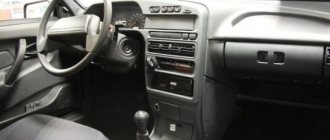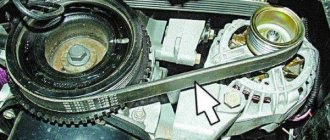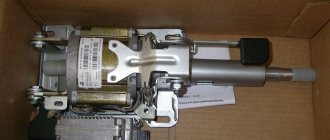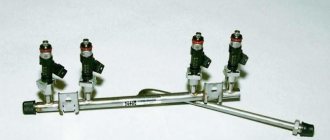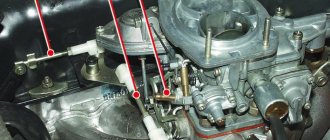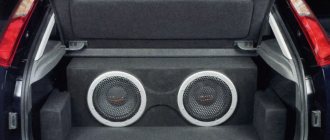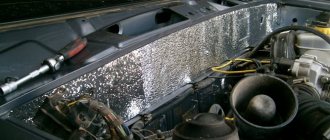Preparation
Many craftsmen advise removing the dashboard before painting. When dismantling, disconnect the negative terminal of the battery, put the car on the handbrake, and remove the screws. Then comes the disconnection of the wires, removal of decorative parts and the steering wheel. The panel is carefully processed; the design must match the material of the torpedo. Wash it with soapy water. Then degrease with acetone or another substance. Then the plastic is sanded with fine sandpaper and treated with a special primer for plastic. Then they degrease again.
Painting with liquid rubber
Before starting work, it is necessary to either dismantle the front panel or seal the non-paintable areas with tape. The method of painting with liquid rubber has not been thoroughly studied, and reviews from drivers are contradictory. Some complain that the gloss goes away quickly, others say that this coating is not reliable, it is easy to scratch and tear off. Still others complain that when they try to paint again, it is impossible to remove this rubber in some places. Liquid rubber is sold in aerosol cans, usually 400 milliliters each. The price ranges from 600 to 800 rubles. The application of a layer of rubber is carried out in 3 - 4 passes, allowing each layer to harden first.
Rubber paint has a number of advantages and disadvantages:
- The surface is pleasant to the touch. Slightly rough - the rubber surface has a positive effect on a person when touched.
- There are no sun glares.
- The paint dries quickly.
- Moisture resistant.
- No smell.
- No seams or bubbles.
- There is no cracking from panel bending.
Applying paint
To paint the panel you will need appropriate paint in pressure cans. For high-quality coverage, two standard-sized cylinders will be enough. The paint is applied in several passes. First, the first layer is applied - it should be thin and sprayed from a greater distance. After applying it, you will be able to clearly see all the defective areas that were missed during sanding and priming. If there are any, then they are processed again either with an abrasive or a primer.
The second and third layers are applied more thickly from a standard distance. At the same time, you need to keep an eye on it. So that the paint does not leak and lies on the surface of the panel in an even layer. After this, the panel is left for some time to crystallize the applied coating. Existing defects are immediately removed and repainted.
Liquid vinyl treatment
Liquid vinyl is a modern product that is successfully used for painting car parts. A thin layer of this coating decorates and protects many suitable surfaces well. This is a high-tech product of excellent quality. Treatment with liquid vinyl will increase the resistance of the panel to the influence of bright rays of the Sun, ice, frost or other harmful compounds. The beauty of this substance is that after prolonged use it comes off easily. And this fact does not reduce its strength qualities.
Painting with liquid vinyl is a simple and understandable procedure for everyone. The processed part will become matte and clean. Liquid vinyl is usually sold in cans. Before use, you need to shake it, it is advisable to do this for at least a minute. The paint and solvent must mix well. Do not touch liquid vinyl until it is completely dry. Otherwise there will be stains.
The process takes place in several stages. The initial level is connecting. They try to make it translucent. This makes it possible to bond the paint to subsequent levels. The first layer will dry for about 30 minutes, this time must be maintained. The number of layers applied depends on you. The more there are, the more durable the coating will be. The recommended quantity is five. Distance from the can to the torpedo: 7 - 9 centimeters. If you did not dismantle the torpedo and sealed parts that were not to be painted, remove the tape and protective material immediately after painting, before the vinyl hardens. The complete drying time for vinyl is 3.5 hours. All this time it is necessary to protect the drying surface from dust and other bodies.
Is it possible to drive if the alternator belt is broken?
Car owners often wonder whether it is possible to drive if the alternator belt has broken. Yes, you will be able to continue your journey, but you will be able to cover a short distance, depending on the battery charge. Therefore, if such a problem happens to you, we recommend driving to the nearest car service center.
Remember to turn off devices that consume electrical energy, such as air conditioning, audio system, GPS navigator, external and internal lighting.
Of course, if the problem happened at night, you need to leave the headlights on, because it is unsafe to continue driving without them. When you arrive at the repair site, do not turn off the engine, as starting it again will cause the battery to discharge faster due to the additional load. But still, if the alternator belt breaks, we do not recommend further movement.
Painting of domestic models
The technique for painting the dashboard of a VAZ car is no different from other cars. The surface is first cleaned of dust and dirt, then treated with soft sandpaper. Primer treatment is required before degreasing. The main thing when spraying is to avoid smudges. This is controlled and achieved by maintaining the correct distance. Before starting the process, shake the can. Plastic is painted in three or four layers. The intervals between visits are from 12 to 25 minutes. Then the panel must dry for more than 10 hours. Then varnish is applied. The number of layers is at your discretion (3 or 4). Downtime between visits is no more than 15 minutes. After complete drying, the panel is put back.
Adviсe
You should think carefully when choosing paint. Then changing the tone will be problematic. Matte black paint is often used. A light-colored car can be updated by painting the dashboard white with a light green, purple or blue tint. These are the most popular options. It is not advisable to experiment with flashy colors. It will look provocative and interfere with driving. The dye has a description that must be strictly followed.
It is advisable to start work with small, ordinary parts. This way you can practice. It is advisable to paint the less visible parts first. And then move on to the center console and climate control panel. For sanding, sandpaper sizes No. 60 and No. 80 are useful. And after the primer has dried, use sandpaper No. 80 and No. 90. The process can be repeated until the perfect surface is achieved.
Torpedo restoration options
We can briefly consider the available methods for restoring a car dashboard. These include the following methods:
As mentioned above, the easiest and cheapest way to return a decent appearance to a torpedo with your own hands is painting and applying a layer of varnish. Some people prefer matte enamels, since deep gloss can cause glare from the sun and interfere with driving. It all depends on the shape of the torpedo and the taste of the owner of the car. In most cases, preference is given to a glossy surface.
Price
The pricing policy for car panel painting is determined based on a number of indicators. The cost of paint, the complexity of the work, possible repairs during painting work, and the responsibility when painting luxury cars are taken into account. In monetary terms, everything starts from 1500 rubles and above. If there is competition, there is not much difference - a provincial town or a metropolitan car service center.
Hello everyone dear friends and readers
I haven’t written anything for a long time, I didn’t have time, but I finally got around to doing what I’ve been wanting to do for a long time, namely, paint the torpedo in “Ultramarine” color. I took the paint and primer at work)))) as usual, I take everything. Well, what can I tell you about painting: we disassemble the panel, first clean all the parts that need to be painted, then degrease, prime and apply the paint layer by layer, I didn’t need varnish since this paint is not covered with varnish. The painting did not take place in one day. I painted my beard on the balcony because the weather initially did not allow me to do this due to the cold weather, a week later, that is, today I painted everything else - the upper and lower glove box, plus the soap dishes for the door handles. I am very pleased with the result, the paint applied perfectly, when you open the door and the sun enters the interior, everything glitters and shimmers, it’s a pity that it’s hard to see on the camera. Now the next thing is to improve the acoustics, but that's a completely different story)))))
Good luck to everyone))) and the implementation of your plans))))) don’t forget to evaluate)))
Purpose and principle of operation
Adsorber - is a container filled with activated carbon, which acts as a filter element. This element is the main part of EVAP - Evaporative Emission Control (gasoline vapor recovery system).
The system has been integrated into the fuel system of cars with Euro-2 standards and higher. Those. you won’t see an adsorber on a VAZ classic or even a 2108 model, not to mention Moskvich, Volga 3110, etc.
The goal is to reduce harmful emissions into the atmosphere and eliminate gasoline odors in the car interior.
But despite the simplicity of the design, in addition to the housing and the filter element, the adsorber consists of:
- Branch pipes: air supply, vacuum, gasoline vapor removal.
- Separator - here the vapors are condensed and drained back into the tank.
- Gravity (emergency) valve – blocks the overflow of fuel when the machine overturns.
- The solenoid valve (or vacuum valve - for example, found on some Nissan models) is one of the important elements (details below).
- Other additional devices (depending on the car model).
Fuel vapors accumulating in the gas tank must go somewhere. In old cars they escaped into the atmosphere through a special tube. In modern vehicles, fuel tanks are isolated from the external environment.
Gasoline vapor, through a separate outlet pipe, enters the adsorber and condenses there in the form of fuel, which is returned back to the tank or to the intake manifold. In the first case, the process occurs with the engine turned off, in the second - with the engine running.
As soon as the car starts, the ECU sends a signal to the solenoid valve. The latter opens and the activated carbon (sorbent) is purged. Fuel vapors are “extracted” from the sorbent and immediately enter a special receiver and then into the combustion chamber.
To find out more about what an adsorber is, follow the link.
Comprehensive modernization of the VAZ-2114 instrument panel: first steps
Most often, a set of works to improve the dashboard of a VAZ 2114 is important and necessary, but at the same time, an interesting and serious task. The main task is to choose the right details and decorate them beautifully. It is always better to think through all actions related to various updates in advance, in advance.
Subsequently, this will avoid unnecessary mistakes and disturbing fuss. The right decision would be to draw up a work plan that you will follow and thanks to which you will not make mistakes, and the whole process will be a complete pleasure for you.
Diesel, hum, clicks and more: strange car sounds that shouldn’t scare
We have already talked about what engine sounds may hint that he is feeling unwell. Hearing an unfamiliar sound, many begin to worry and worry, and the most suspicious drivers put a Validol tablet under their tongue and go to a car service center. Where, by the way, they often take advantage of their panic and try to repair something that does not need to be repaired. Of course, the appearance of anxiety is the correct reaction. But the machine (and it is still a heap of iron) not only can make noise, but simply must. And some of its sounds should not be scary. Let's see what kind of noise from a car should not make its owner hysterical.
Required Explanation
Before you put one ear to the engine and the other to the gearbox, you need to think about the fact that some sounds have a right to exist on one car, but not on the other. In other words, “dieseling” a Ford or Kia engine are completely different things, and in the first case there is no need to strain, but in the second it is very necessary. Therefore, we will try to discuss such things separately.
The second is a category of sounds, the cause of which is so banal that it is not worth talking about them at all. Such sounds frighten either completely inexperienced drivers, or people who have just changed their car and are not yet accustomed to the fact that it works differently from the previous one. For example, a simple situation: a person in a crisis moved from a foreign car to a VAZ-2115 (ugh three times). I drove all winter, and in the spring I drove for the first time with the window down and suddenly I heard a terrible rumble ahead. And it was just the fan turning on, which was practically inaudible on a foreign car.
Lada Samara (2115) '1997–2012
Or suddenly, at speed, something began to buzz in a recently purchased car. The reason, perhaps, lies in aerodynamics: the side mirrors howled, and on the old “classics” there were drains. This is also too simple and elementary, so we’ll just warn you that there are very simple, loud, but not scary sounds that we won’t talk about. We'll look for something more complicated. Let's start with the engines.
What is good for an American is death for a Korean
Let's start with a light sound that often frightens the car owner - with a barely noticeable clatter. A quiet clattering sound, more like a chirping sound, is the sound of the injectors operating. Whatever they say about the complex design of the nozzle, it is just an electromechanical valve, and it cannot work completely silently. On some engines, the injectors are almost inaudible, while some “slam” noticeably. For example, this sound can often be heard on Korean engines. Of course, there is no need to be afraid of him.
True, if your hearing is not very keen, and you have no experience at all, this noise can be mistaken for a knock in an incorrectly set thermal clearance of the valves. But in fact, the valve clatter is much louder, and, in addition, it usually becomes quieter as the engine warms up (the gap becomes smaller and it does not thrash as much), but the injectors work the same at any temperature. So if the clatter is strong and decreases as it warms up, it’s time to adjust the gaps (or check the hydraulic compensators, if any), and if it is frequent, barely audible and does not change, then there is no need to worry - it’s the injectors that are working.
The second sound is less pleasant and louder. For its characteristic shade it is called “diesel”. Well, a diesel engine always “diesels” - the sound of even a working engine resembles a knock. But running a diesel engine on a gasoline engine can be annoying. But not always.
This phenomenon during a cold start is characteristic of many units, but it is not a sign of their impending demise. As an example, we can cite the engines of the Zetec series, familiar to us from Fords, primarily the 1.6-liter engine with 100 hp. The engine will soon be a hundred years old (okay, okay, a little less), but there is still no exact answer to what is knocking in it.
Most often, the blame is placed on the “pin-piston” connection, in which play appears, and when the piston is moved, a knock appears at the bottom dead center. Short piston skirts are almost as often blamed. Someone is very worried and begins to slowly rebuild the engine or at least adjust the valve clearance (this engine does not have hydraulic compensators). Adjusting the valves has never hurt anyone, but it doesn’t get rid of diesel. And since with this knocking “zeteki” quietly drive for 400 thousand kilometers, diesel engine was recognized as a “design feature” that does not affect the resource in any way.
I note that I myself had a first-generation Focus with such an engine, but with a volume of two liters. It drove without repair until it covered 420 thousand kilometers, was sold with a handwritten contract to Moscow, after which I received fines for another year from Chuvashia, Udmurtia and Tatarstan. Apparently, 420 thousand is far from the limit for a diesel Zetec, and I had to stop registering this car with the traffic police. By the way, there was no “oil burn” during this run. Therefore, if the car’s engine is one of those that has the right to run a little diesel after a cold start, you shouldn’t worry about it. Yes, this is rather an exception, but it exists.
In addition to Zetec motors, this includes motors of the EA111 series - CFNA and CFNB. There the situation is a little more complicated: sometimes the knocking is caused by wear of the piston group, leading to a decent amount of oil leakage. And at the same time, for many, simple 1.6-liter engines with multipoint injection knock on for tens of thousands of kilometers without falling apart or suffering from other “diseases”. The main thing is not to confuse this sound with the knocking of the timing chain. You still have to change the chain.
Although there is an exception here too. For example, the Opel Z12XEL engine produced before 2010. The cause of its characteristic “dieseling” is precisely the chain, but there is nothing terrible: it is enough to replace the not very successful hydraulic tensioner. The chain and gears themselves last a long time, but the efficiency of the tensioner turned out to be insufficient. It was replaced in 2010 and the problem went away. Therefore, if you hear a strange sound from under the hood, for example, of your Opel Corsa D, do not rush to change the entire timing chain drive: very often the reason is much cheaper and simpler. So it’s too early to panic, you need to look for a good specialist.
Tuning the dashboard can be performed in the following sequence:
- First you need to disassemble the car “device”. Every car enthusiast should know how to remove the instrument panel of a VAZ 2114. There is nothing complicated here, everything is quite clear, and the process itself does not require special skills or knowledge.
- Then it is necessary to refine the elements and parts. There can always be many nuances here. They depend on what you want to change and improve in your car. Everything should be thought through very carefully.
- At the end, you need to install the remade, updated “socket” into place.
Removal
1. Prepare the car for work and disconnect the terminal from the negative terminal of the battery (see “Preparing the car for maintenance and repair”). 2. Using a Phillips screwdriver, unscrew the three self-tapping screws securing the left trim of the instrument panel console.
3. Remove the trim, removing the protrusion in its lower part from the body bracket.
How to easily update the “tidy” of a VAZ 2114
Upgrading the 2114's dashboard is actually not as complicated as it might seem at first. Buying such a “device” is quite simple. You should consider what options owners can use to update their VAZ 2114 wardrobe (examples in photos and videos).
1. AMS. This model has several features.
- To begin with, it is worth noting that you can order its design yourself;
- This panel is equipped with an integrated oil indicator, which is missing in the classic version. Its appearance is associated with the very persistent requests of many car enthusiasts to install this “component” as standard.
- This instrument panel looks more interesting due to the colored scales with chrome trim.
2. PRO-SPORT. This “tidy” is designed as an overlay for the instrument panel on the presented model. The updated design of this device gives them an impressive, completely new look. There are two options for its execution: with a light and dark backing. The backlight of the VAZ 2114 panel has a special brightness adjustment, but there is only one color - blue. The scales are glued after installing the insert. This is to give this element of the car an original look.
3. AMS-2. The central instrument was the tachometer, which was moved from left to center. The white scales create an overall sporty look for the entire panel. This allows you to quickly read the necessary information from it. The backlight has been redesigned and LEDs are used, with the help of which it is not difficult to read information at night. Installation is recommended to be carried out by qualified specialists, since its installation involves significant “redevelopment” of the classic model.
4. STREET STORM. The main feature of this model is its color design. Nothing was changed in the classic arrangement of instruments,
the emphasis was on the color scheme. The “appearance” of the dashboard has undergone certain changes, however, at the same time, its style fits harmoniously into the existing interior. Another feature of this model should be noted – its backlight. During the day it is light with red symbols. In the dark, you can easily change not only the brightness, but also the color.
Where to begin
Before starting work, we recommend that you carefully study the dashboard structure. If you understand what and how, then it will be much easier for you to remove the torpedo. If you have already become familiar with the structure of the shield, you can begin work. You should start by dismantling the screens. This is done as follows.
- We take a positive screwdriver and carefully remove the three screws that secure the left screen. If you have a tool with a short tip, it is better to use it, it will be more convenient.
- We remove the lower part of the lining from the mounting on the body.
- We do the same with the screen on the right side. The only difference is that it is fixed with 5 screws. While working, carefully hold the pad with your hand.
Now that all the fasteners have been removed, you can remove the screen. But be careful that it doesn't get caught on the wires underneath it. Otherwise, you may simply break the cables.
Next, you should disconnect the ground from the battery. This is done by disconnecting the pads. If a radio is installed in the car, it must be disconnected from the wiring. If you do not have any audio devices installed, you can simply remove the wires (they are closed with a plug). Then the cigarette lighter and the socket that illuminates the ashtray are turned off.
So, the first stage of work has been completed. You can proceed to the next steps.
Tuning for your pleasure
The main thing in the process of modernizing any car is efficiency. Every owner would like his car to look original and, at the same time, to feel comfortable in it. Oddly enough, the instrument panel is considered one of the favorite parts for tuning enthusiasts. It can be modified in different ways and, thus, distinguish your own car from a huge number of similar machines.
At the starting stage, it is necessary to prepare the material for work. Replacing a VAZ 2114 panel or its original update requires dismantling the standard panel. It will only be necessary to remove the speedometer protective glass. It is important not to break it. After removing the protective glass, you need to “uninstall” the arrows and indicators.
It is important to be careful as the arrows are very fragile. After that, pull out the standard tab. Then you need to change the backlight bulbs. The standard ones were green, but the purchased ones will be blue. We replace standard light bulbs with purchased ones, then check how they work. After that, install a new tab.
All this will look very impressive. At the end we install directional arrows and protective glass. If you modify your car in this way, it will look very beautiful.
Experience of car enthusiasts
The 10 and 14 have absolutely identical panels. I immediately installed the cover and changed all the light bulbs to LEDs... and in general I installed LEDs everywhere I could. Energy consumption on the car has dropped significantly.
Denis
https://www.2114.ru/forum/showthread.php?t=73
The overlay is the same combination of arrows, you don’t need to remove anything extra on top of the original one, everything that is sold ready-made, like a new panel, is basically *waste, they take a standard Vase panel, put inserts there and sell it for 5 rubles more.
Alik 115
https://www.2114.ru/forum/showthread.php?t=73
3.5 years have passed, the panel feels great) the paint is not peeling, everything is fine in this regard) You can safely paint it.
mr-ruslan89
https://www.drive2.ru/l/8309496/
Folks, I generally found a simple solution for myself. This paint is sold under the name BMWSHWARTSMATT or what it is (I don’t remember exactly). The paint is specially designed for painting the dashboard in a matte black color (It turns out one-on-one like on a BMW. Hence the name?) It is sold from BMW officials and costs about 1000 rubles per can for the torpedo and the interior trim for the VAZ 2114 required 4 cans. Since I work at Land Rover, we have paint and purchasing it costs about 700 rubles. It reacts to heat in parallel, does not stink in the car, it smells like a BMW)))
Bimmer
https://club2108.ru/forum/viewtopic.php?id=2757
The backlit arrows are cool. I once wanted to do it myself, but then I somehow changed my mind, I just decided not to bother. And the options for upgrading the panel are really normal.
Bojarin
https://vsepoedem.com/story/panel-vaz-2114-vozmozhnye-varianty-modernizacii
Europanel is undoubtedly good. But it still starts to creak after a while, no matter how you look at it.
2108
https://vsepoedem.com/story/panel-vaz-2114-vozmozhnye-varianty-modernizacii
There are many options for changing the dashboard and each owner can choose the one that suits them. Almost all the work can be done independently. Experts point out that you should not cut off the protruding parts yourself or build up additional walls. This is due to the fact that when developing a factory panel, certain calculations are carried out to make it safe for both the driver and passengers.
419c7cu-960.jpg
To begin with, the question arises: what is it good for? The old panel was made, to put it mildly, quickly: the steering wheel covers part of the instruments, the “tidy” itself is reflected on the windshield at night, thus turning the road into a computer quest.
Plastic, or rather its quality, does not stand up to criticism. After traveling several hundred kilometers, the entire cabin is filled with an obsessive creaking and terrible roar. Later the glove compartment begins to open. Ventilation is poor and it is cold inside the car in winter. However, all these problems can be solved. However, is it worth buying a car and immediately thinking about repairing it?
Another thing is the Europanel. She looks modern and fashionable. The material is softer and richer. It is certainly less noisy. Ventilation is also good.
Domestic assembly can be felt everywhere. The air flow control levers move slowly and do not reach the edges of the slots. There are also other little things: there is a big gap somewhere, something else falls off, the glove compartment sometimes opens by itself. But in terms of quantity and frequency, this is completely incomparable with the old version.
In addition, several drawers for small items warm the soul. Europanel is a modern and original solution to many problems associated with the “tidy” of domestic cars.
Why does the radiator pipe shrink and burst?
One of the dangerous manifestations of a malfunctioning cooling system is a violation of the geometry of the radiator pipes. Why is the situation dangerous if the inlet or outlet pipes of the radiator flatten when the engine has cooled down, and when warmed up they gradually return to their normal state? Why is this happening, can I solve the problem on my own?
About pressure in the cooling system
To effectively remove heat from the engine jacket, liquid cooling systems are hermetically sealed from the environment and can withstand pressure from 1.2 to 2 or more atmospheres. This is necessary to prevent the coolant from boiling when the temperature reaches 100°C. At elevated pressure, various brands of antifreeze and antifreeze can boil when heated to 107°C−120°C, and sometimes 150°C.
Technical means to increase pressure in the cooling system are not used. The required values are achieved due to a natural increase in the volume of heated liquid circulating in the “jacket” of a running engine. Excess pressure is released through the system expansion tank cap, equipped with special valves, in which a certain amount of air is always present.
Bends and cracks in radiator pipes
The excess air released during the expansion of antifreeze or antifreeze in the tank after stopping and cooling the engine is compensated from the atmosphere through the second check valve of the lid. If this does not happen, a vacuum is created in the tank, radiator, connecting pipes and engine jacket. The first to react to this by compression are the least durable elements of the system - the rubber radiator pipes.
The maximum possible value of negative (compared to atmospheric) coolant pressure depends on the temperature difference between the heated and cooled engine. It is no coincidence that motorists notice this problem in winter, when the temperature range is greatest. In this case, the pipes wear out quickly and, having lost their initial elasticity, can burst. The vehicle cannot be operated with such a malfunction.
Expansion tank cap: design features
In addition to the plastic body, threaded part and sealing gasket, the tank lid is equipped with two valves: inlet and outlet. Each of them is designed and must operate under certain conditions. The first opens at excess pressure - for example, 1.2 Bar. The second is needed to compensate for pressure when the antifreeze cools down. If this valve fails, a dangerous level of vacuum is created in the system.
The solution to the problem is to flush the valves or buy a new cap.
The metal parts of the valves may simply be clogged with dirt from the cooling system if it has not been flushed for a long time. In such cases, the problem can be temporarily eliminated by blowing and cleaning the lid valves. If there are repeated failures, you will have to start with a general flush of the entire cooling circuit. If the valve malfunction is due to corrosion of their metal elements, you should purchase a new cover.
How to identify a malfunction
In order to make sure that the radiator pipes are flattened precisely because of the strong vacuum in the cooling system, and the reservoir cap is to blame, it is enough to unscrew the latter a little (only on a cold engine). A characteristic whistle of incoming air will indicate a clogged or rusted check valve. If there is no whistle, you need to flush the entire system. In this case, it is better to start with the upper radiator pipe, which connects it to the expansion tank.
Why buying a new cover may not solve the problem
Unfortunately, the simplest part costing a few rubles does not always meet the requirements. The lid may not function due to a significant difference in pressure at which the valves installed in it open or close. You can check their serviceability and response threshold using a compressor for inflating tires, and adjust it by reducing the number of turns of the corresponding spring. Or simply buy and install a cover from another manufacturer.

